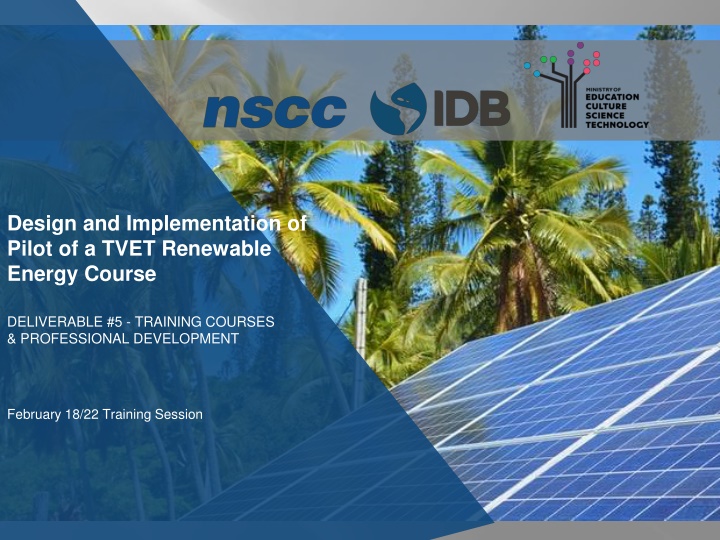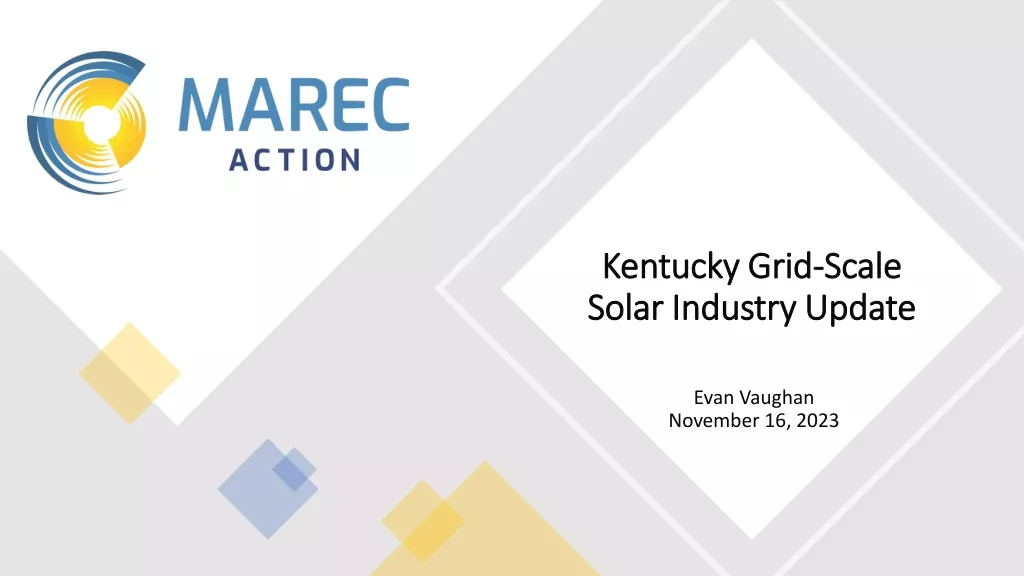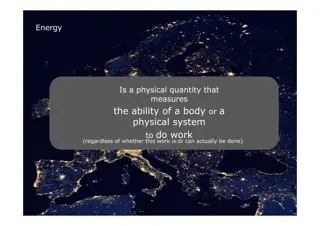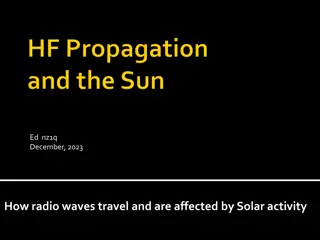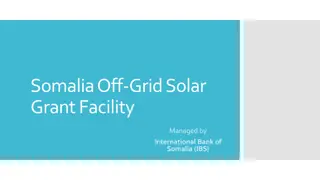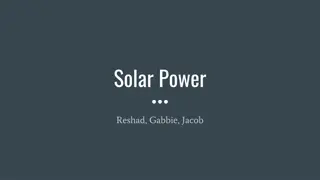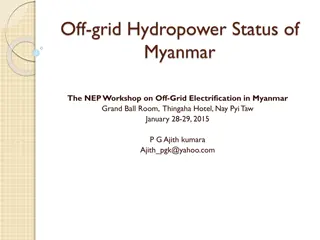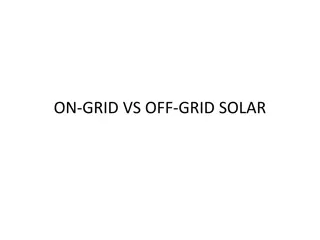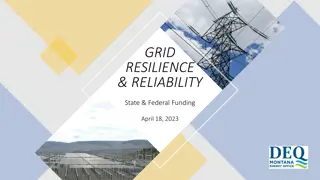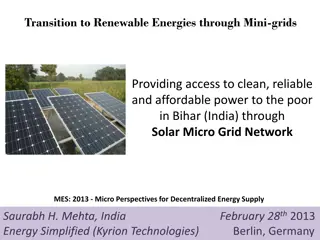Hands-On Training on Basic 12 Volt Off-Grid Solar System Components
This training session focuses on the basic components of a 12-volt off-grid solar system, including solar PV panels, charge controllers, and batteries. Participants will learn about proper handling of PV panels and measuring essential values like Voc and Isc using digital multimeters. The course includes practical sessions with different panel types and emphasizes the importance of accurate measurement tools for solar systems.
Download Presentation

Please find below an Image/Link to download the presentation.
The content on the website is provided AS IS for your information and personal use only. It may not be sold, licensed, or shared on other websites without obtaining consent from the author.If you encounter any issues during the download, it is possible that the publisher has removed the file from their server.
You are allowed to download the files provided on this website for personal or commercial use, subject to the condition that they are used lawfully. All files are the property of their respective owners.
The content on the website is provided AS IS for your information and personal use only. It may not be sold, licensed, or shared on other websites without obtaining consent from the author.
E N D
Presentation Transcript
Design and Implementation of Pilot of a TVET Renewable Energy Course DELIVERABLE #5 - TRAINING COURSES & PROFESSIONAL DEVELOPMENT February 18/22 Training Session
Basic Solar System Off-Grid
Basic 12 Volt Off-Grid Solar System There are three basic components that make up the basic 12 volt off-grid system. Solar PV panel Charge Controller Battery
Basic 12 Volt Off-Grid Solar System The hands-on training will consist of the basic components as well as proper handling of the PV panel. There will be two different panels for the training. A 50 Watt 36 cell panel A 120 Watt 36 cell panel Panels come in standard cell configurations
Basic 12 Volt Off-Grid Solar System The two labels from the back of the panels. Look for Voc (Voltage Open Circuit) and Isc (Short Circuit Current). Picture courtesy Southern Solar Solutions
Basic 12 Volt Off-Grid Solar System This one is the 50 Watt panel. Voc = 21.55 volts Isc = 3.05A These are the STC ratings. Picture courtesy Southern Solar Solutions
Basic 12 Volt Off-Grid Solar System This one is the 120 Watt panel. Voc = 22.3 volts Isc = 7.16A These are the STC ratings. Picture courtesy Southern Solar Solutions
Basic 12 Volt Off-Grid Solar System To measure the values of Voc and Isc requires a digital multimeter. The multimeter must be able to read the range of values that the solar system can produce. The multimeter must have an inline Ammeter capable of reading DC. A clamp-on DC Ammeter can also be used if the multimeter can take the range of voltage that makes the readings accurate.
Basic 12 Volt Off-Grid Solar System To measure the values in a solar PV system it is best to have a True RMS multimeter. True RMS meters accurately measure non- sinusoidal waveforms. Regular multimeters cannot accurately read the non-sinusoidal waveforms that are generated by certain solar related equipment.
Basic 12 Volt Off-Grid Solar System Some examples of the True RMS measuring meters. Picture courtesy Author
Basic 12 Volt Off-Grid Solar System An example of a clamp-on, this one is an F.W.Bell model CG-100A. 100 Amp clamp-on. Picture courtesy Author
Basic 12 Volt Off-Grid Solar System Most DC clamp-on Ammeters require a zeroing to calibrate the reading. This one has selectable range 10A or 100A. 1 volt output to multimeter. Picture courtesy Author
Basic 12 Volt Off-Grid Solar System Output to DC voltage input on multimeter. Picture courtesy Author
Basic 12 Volt Off-Grid Solar System An example of a clamp-on, this one is an Fluke i410. It is both a DC and an AC Ammeter. It also needs to be zeroed before use. 400 Amp clamp-on. Picture courtesy Author
Basic 12 Volt Off-Grid Solar System An example of a clamp-on, this one is a Southwire. True RMS is stated on the meter. Picture courtesy Southern Solar Solutions 400 Amp clamp-on.
Basic 12 Volt Off-Grid Solar System An example of a clamp-on, this one is a Truper. True RMS is stated on the meter. Picture courtesy Southern Solar Solutions 600 Amp clamp-on.
Basic 12 Volt Off-Grid Solar System The next major component is the charge controller. The charge controller is an electronic interface between the PV panel and the battery. It can also be able to control the DC loads as well.
Basic 12 Volt Off-Grid Solar System This particular charge controller is not mass produced. It will be the one used for training. Picture courtesy Southern Solar Solutions
Basic 12 Volt Off-Grid Solar System Charge controllers take the energy from the PV panel and adjust the voltage going to the battery. The voltage range the charge controller can accept will be in the specifications. The current it can feed to the battery and or load is also in the specifications.
Basic 12 Volt Off-Grid Solar System Today s training will use this charge controller. It is designed for a 12 volt battery and it can charge at 10 Amps. Mark will explain the details of this model during the training. Picture courtesy Southern Solar Solutions
Basic 12 Volt Off-Grid Solar System When selecting a charge controller there are a few options to consider. Charge stages Pulse Width Modulation (PWM) MPPT (Maximum Power Point Tracking) Display or indicators
Basic 12 Volt Off-Grid Solar System The charge controller for today s training is a PWM type with 3 stage charging and has indicator lights. This charge controller is for Lead Acid batteries. Lead Acid batteries require three stages of charging.
Basic 12 Volt Off-Grid Solar System The three stages are: Bulk, where the charge controller puts the maximum amount of current into the battery until a maximum voltage is reached or a defined period of time has elapsed. Absorb, where the voltage is maintained for a defined period of time to allow the battery to not over heat. Float, where the battery is held at a lesser voltage until the start of the next day Bulk charge.
Basic 12 Volt Off-Grid Solar System This charge controls the current and voltage to the battery with PW. The duty cycle of the controlling device (MOSFET usually) changes to satisfy the condition of each stage of charging. MPPT will be discussed at a later session.
Basic 12 Volt Off-Grid Solar System The battery used in this training session is of the Lead Acid type. There are three basic types of Lead Acid batteries. Flooded Gel AGM
Basic 12 Volt Off-Grid Solar System Flooded The medium to hold the acid in suspension is distilled water. Hydrogen gas is produced and needs to be vented. The battery needs to be held in the upright position only. An Equalization charging stage is required. (More on this in another session)
Basic 12 Volt Off-Grid Solar System Gel It is classified as a Valve regulated VRLA In a gel cell battery, the electrolyte does not flow like a normal liquid. The electrolyte has the consistency and appearance of petroleum jelly. Self discharge is less than a flooded type. No Equalization Charge required
Basic 12 Volt Off-Grid Solar System AGM (Absorbed Glass Mat) It is classified as a Valve regulated. The cell is encapsulated in fiberglass. Shelf life of a VRLA battery is seven times higher than the shelf life of a deep cycle flooded battery. Overcharging however is especially harmful to any VRLA battery because of the sealed design (No Equalization charge).
Basic 12 Volt Off-Grid Solar System The AGM battery for the training is: Picture courtesy Southern Solar Solutions
Basic 12 Volt Off-Grid Solar System The AGM battery for the training is: The DC25-12 is the model. DC represents Deep Cycle. It is of the AGM type. 35 is the Ah at the 20 hour rate. 12 is the nominal voltage of the battery. Picture courtesy Southern Solar Solutions
Basic 12 Volt Off-Grid Solar System The nominal voltage for this battery is 12 volts. This is a standard value. Fully charged the terminal voltage at rest will be 12.65V. Completely discharged the terminal volts will be 10.50V. The voltage difference between fully charged and discharged is 2.15 volts.
Basic 12 Volt Off-Grid Solar System The Ah rating is how many amps the battery can supply over a give time interval. The 35Ah for this battery is at the 20 hour interval. The battery when fully charged can deliver 1.75 Amps to a load for 20 hours before becoming completely discharged. 1.75A x 20h = 35 Ah 100 hour rating is 39Ah 20 hour rating is 35Ah 10 hour rating is 32Ah 5 hour rating is 29Ah The faster the discharge the less efficient the battery.
Basic 12 Volt Off-Grid Solar System Balance of System (BOS) is the remaining equipment to connect the PV panel to the charge controller and the battery. Wire Overcurrent Protection Disconnection Means
Basic 12 Volt Off-Grid Solar System Wire needs to be rated for the following: Maximum voltage it maybe subjected to. 125% of maximum current to be imposed on to it. Insulation rated for the maximum temperature it will be exposed to. Insulation rated for the environment it will be exposed to.
Basic 12 Volt Off-Grid Solar System Overcurrent protection needs to be rated for the following: Maximum voltage it maybe subjected to. 125% of maximum current to be imposed on to it. Identify if overcurrent can be opened under load or not. Breakers can be used as both overcurrent protection and a disconnection means.
Basic 12 Volt Off-Grid Solar System Today training will use a DC rated breaker: This breaker is DC rated Rated at 250 Vdc 6000A interrupting rated 10 Amp trip setting It also can be opened unload, which makes it suitable as a disconnection means. Picture courtesy Southern Solar Solutions
Measurements: Panel Wattage__________________________ Voc ___________Isc_________ Solar irradiance calculation from Isc______ Battery Voltage before connection_______ Initial Battery Amperage_________ Initial Battery Voltage__________
Measurements when system has started: Panel Voltage__________Panel Amps_______ Panel Wattage ___________(VxA measured) Battery Voltage charging_______ Battery Amperage charging_________ Battery Voltage charging_______ Battery Amperage charging_________ Battery Voltage charging_______ Battery Amperage charging_________
